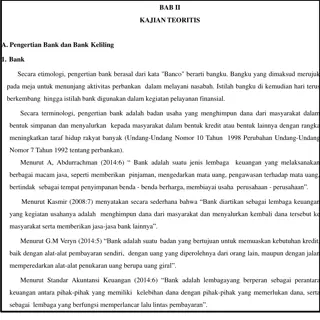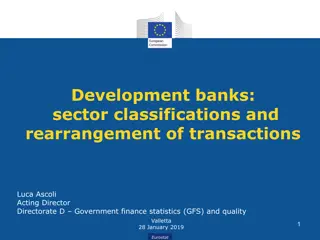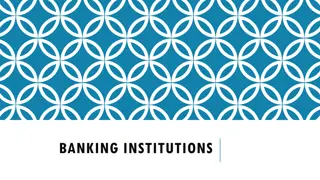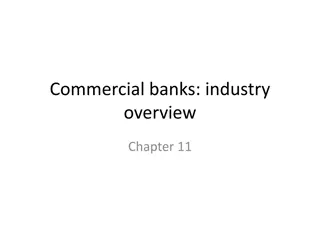Strategies for Resolving Non-Performing Loans in African Central Banks
Central Bank of Nigeria's Banking Supervision Department addresses the evolution, causes, and strategies for managing non-performing loans (NPLs) in the Nigerian banking sector to ensure financial stability. The Central Bank regularly monitors NPL ratios and implements reforms to prevent bank failures due to NPLs.
Download Presentation

Please find below an Image/Link to download the presentation.
The content on the website is provided AS IS for your information and personal use only. It may not be sold, licensed, or shared on other websites without obtaining consent from the author.If you encounter any issues during the download, it is possible that the publisher has removed the file from their server.
You are allowed to download the files provided on this website for personal or commercial use, subject to the condition that they are used lawfully. All files are the property of their respective owners.
The content on the website is provided AS IS for your information and personal use only. It may not be sold, licensed, or shared on other websites without obtaining consent from the author.
E N D
Presentation Transcript
CENTRAL BANK OF NIGERIA RESOLUTION OF NON-PERFORMING LOANS: WHAT STRATEGIES FOR AFRICAN CENTRAL BANKS? Presented by EBOAGWU.H.O. EZULU Banking Supervision Department, Central Bank of Nigeria (CBN). At the Second AACB Continental Seminar for Year 2021. June 28 2021
OUTLINE I. INTRODUCTION II. EVOLUTION OF NON-PERFORMING LOANS (NPL) III. CAUSES OF GROWTH OF NON-PERFORMING LOANS IV. STRATEGIES ADOPTED BY THE CBN TO MANAGE NPLs IN THE NIGERIAN BANKING INDUSTRY V. CONCLUSION This document is for CBN internal consumption
INTRODUCTION One of the core mandates of the Central Bank of Nigeria (CBN) is the promotion of the safety, soundness and stability of the financial system. The huge and rising Non-Performing Loans (NPLs) has at one time or the other threaten the safety and stability of the financial system The Nigerian banking sector has over the decades witnessed different episodes of banking crises and bank failures largely attributable to high incidences of NPLs. Other factors such as illiquidity and under- capitalization have also threatened the stability of the financial system. The global financial crisis of 2007/2008 and the Nigerian banking sector crisis of 2009 highlighted the need for more robust regulatory measures to deal with the problem of NPLs and enhance the stability of the financial system. Consequently, the CBN introduced several reform measures to address the problem including initiatives to strengthen the effective supervision of banks. This document is for CBN internal consumption
INTRODUCTION (Contd) The problem of NPLs) is of major concern to regulators because it is one of the causes of bank failure. A loan is termed non-performing when there is a default in scheduled payments for at least 90 days. The NPL ratio is one of the measures used to assess the soundness of a financial institution. The Central Bank of Nigeria (CBN) regularly monitors banks compliance with the prescribed prudential maximum limit on NPLs as part of measures to ensure the safety and soundness of banks. The late 1980s and early 1990s witnessed the era of rising NPLs in the Nigerian banking industry. Some identified causes of the NPLs were: Existence of predatory debtors who abandoned their loan obligations in one bank and obtained another loan in other banks Weaknesses in the credit status checks by banks on borrowers as some banks did not respond promptly to enquiries by other banks Lack of sound risk management practices in some banks which continued to extend more loans to customers that had non-performing loans Paucity of information on the part of regulators to aid the assessment of banks loan portfolio This document is for CBN internal consumption
EVOLUTION OF NPLs IN THE NIGERIAN BANKING INDUSTRY - Between 2000 and 2004, the Nigerian banking industry faced another non-performing loan challenge following the high level of insider loans. This was peculiar to individual or family owned banks. The overbearing insiders engaged in adverse selection of obligors by extending loans to least qualified borrowers, to the detriment of the going concern of the banks. The consolidation of the Nigerian banking sector in 2005 led to the emergence of 25 well capitalized and strong bae nks. However, the banks soon began to engage in excessive risk-taking owing to the level of capital and liquidity at their disposal. Consequently, many of the banks financed mostly big-ticket transactions in the Oil & Gas sector and granted margin loans as well as took proprietary positions in the capital market following the boom recorded in the market at the time. The sudden crash in oil price and the stock market in 2007/2008 left the banks with huge non-performing loan portfolio. This was further worsened by the inadequate collateral coverage for most of the loans. This document is for CBN internal consumption
EVOLUTION OF NPLs (Contd) Other factors that accounted for the increase in NPLs were: - The global financial meltdown of 2007/2008 - Poor corporate governance and risk management practices in banks - Weaknesses in regulatory provisions and practices In response to these developments, the CBN introduced measures to mitigate rising NPLs which contributed to the tempering of NPL ratios from double digits in 2009 to an average of 6% currently. These measures included: The establishment of the Asset Management Corporation of Nigeria (AMCON) Introduction and enhancement of the Credit Risk Management System (CRMS) and licensing of private credit bureau, Grant of regulatory forbearances Implementation of the Bank Verification Number (BVN) initiative Introduction of the Global Standing Instruction (GSI), amongst other initiatives This document is for CBN internal consumption
CAUSES OF THE GROWTH IN NPLs The factors that contributed to the rise in non-performing loans can be categorized into Internal and External factors. The following are some internal factors that have been identified: - Poor corporate governance practices in banks. Examples of such practices include: indiscriminate management override of risk assessment criteria set in credit policies, high unsecured loans granted to significant shareholders and directors - Weak risk management practices and lax internal controls which include: failure of banks to establish sound credit risk policies and practices, poor implementation of such policies, poor credit underwriting practices, granting of foreign currency denominated loans without ensuring natural hedge is in place - Credit concentration to a sector and obligor (especially to vulnerable sectors such as the Oil and gas) - Ineffective credit monitoring practices This document is for CBN internal consumption
CAUSES OF THE GROWTH IN NPLs (Contd) - Lack of knowledge on the part of banks, on the business/project being financed. This negatively impacts the ability to make sound judgement about how to structure such loans - obligation Loan mis-match: Granting of short term loans to meet long term External determinants of accumulation of non-performing loans include: - Government pronouncements - Sharp adverse foreign exchange movement - Heightened financial fragility in the economy - Economic shock which resulted in liquidity challenges This document is for CBN internal consumption
STRATEGIES AND REGULATORY MEASURES BY THE CBN TO MANAGE NPLs IN THE NIGERIAN BANKING INDUSTRY The CBN has deployed multi-pronged measures to tackle identified causes of NPLs increase and these have yielded the desired results. Some of the initiatives that have been deployed by the CBN to address the rising NPLs include: Establishment of the CBN Credit Risk Management System (CRMS) to address the challenge of paucity of credit information. This system is web-enabled and provides a central database from which consolidated credit information of borrowers can be obtained. There are regulations that require all banks to render monthly information on all credits availed to their customers to the database. The database is accessible by all DMBs; they therefrom obtain information on obligors credit history. Issuance and application of the Prudential Guidelines to guide credit processes and practices. The guideline is under review and it has helped to address observed lapses and strengthened regulations. The review of the guidelines is to address current realities. 1) 2) Licensing of private credit bureaux to collect information from banks and available sources on an obligor s or potential borrower s credit history. All banks are mandated to register with a minimum of two credit bureaux to source information on their customers before granting credit facilities. 3) This document is for CBN internal consumption
REGULATORY MEASURES TO MANAGE NPLs ESTABLISHMENT OF AMCON One of the far-reaching measures taken by the CBN to address the problem in the Nigerian banking industry was the establishment of the Asset Management Corporation of Nigeria (AMCON) in July 2010 to among others serve as a failure resolution and asset restructuring vehicle. The AMCON initiative followed the study of models in countries such as the United States, China, Malaysia, Ireland, Sweden and South Korea. The Corporation commenced operations sequel to the issuance of The Guidelines for the Operations of AMCON by the CBN on November 15, 2010. The establishment of AMCON significantly contributed to addressing the huge NPLs of over N1 trillion (USD 2.43 billion). The Corporation took over the toxic and other Eligible Bank Assets (EBAs) of banks, thus freeing their balance sheet from the burden of the NPLs. This led to several salutary benefits which included: Lower NPLs in banks loan portfolios The creation of new quality risk assets and reduction in loan provisioning requirement leading to improvements in banks capital positions Reduced exposure of depositors' funds of over N3.6 trillion (USD 8.76 billion) to the risk of loss. This document is for CBN internal consumption
STRATEGIES TO MANAGE NPLs Contd Other strategies employed include: Strengthening the corporate governance practices, by capping the tenure of all bank Chief Executive Officers 10 years in our Code of Corporate Governance. Credit concentration limit: In 2013, the CBN issued a circular reviewing risk weights assigned to some identified exposures to discourage excessive risk taking and encourage diversification of credit portfolio. A risk weight of 150% was assigned to all sectoral exposures in excess of 20% of total credit facilities. Regulations are also in place to address the limit of exposure to insiders and single obligors. The CBN also issued directive on the strengthening of the Risk Management frameworks of banks. This document is for CBN internal consumption
STRATEGIES TO MANAGE NPLs Contd Introduction of the Bank Verification Number (BVN) has helped in consolidating multiple individual and corporate accounts and improved efforts of banks to identify some chronic credit customers who borrow loans using different company s name. Introduction of the Global Standing Instruction (GSI) in 2019 by the CBN to curb the predatory impact of serial debtors in the Nigerian banking industry. The idea is to ensure that funds of defaulting obligors with other banks are used to off-set the outstanding due obligations. The GSI has helped to bring down NPLs. This document is for CBN internal consumption
STRATEGIES TO MANAGE NPLs Contd In 2020, the CBN approved regulatory forbearance for the restructuring of credit facilities impacted by the COVID-19 pandemic to cushion the impact on obligors. Some of the policy measures include: - Extension of moratorium on all CBN intervention facilities by a year - Reduction of interest rate on all intervention facilities Banks were granted leave to consider temporary and time-limited restructuring of the tenor and loan terms for companies that were adversely impacted by the outbreak of the COVID- 19 pandemic - To further empower the CBN in its enhanced supervision of banks the National Assembly enacted the Banks and Other Financial Institutions Act (BOFIA) 2020 with the introduction of bail-in tools in the resolution of failing banks and other financial institutions. This document is for CBN internal consumption
CONCLUSION The CBN continues to monitor the trend of non-performing loans in the banking sector and have evolved strategies to ensure that it does not threaten the stability of the banking system in Nigeria. The various strategies that have been employed have helped to resolve the huge NPLs and considerably drive down the average NPL ratio from about 35 per cent immediately after the 2008/2009 financial crisis to the current level of about 6 per cent. This document is for CBN internal consumption























